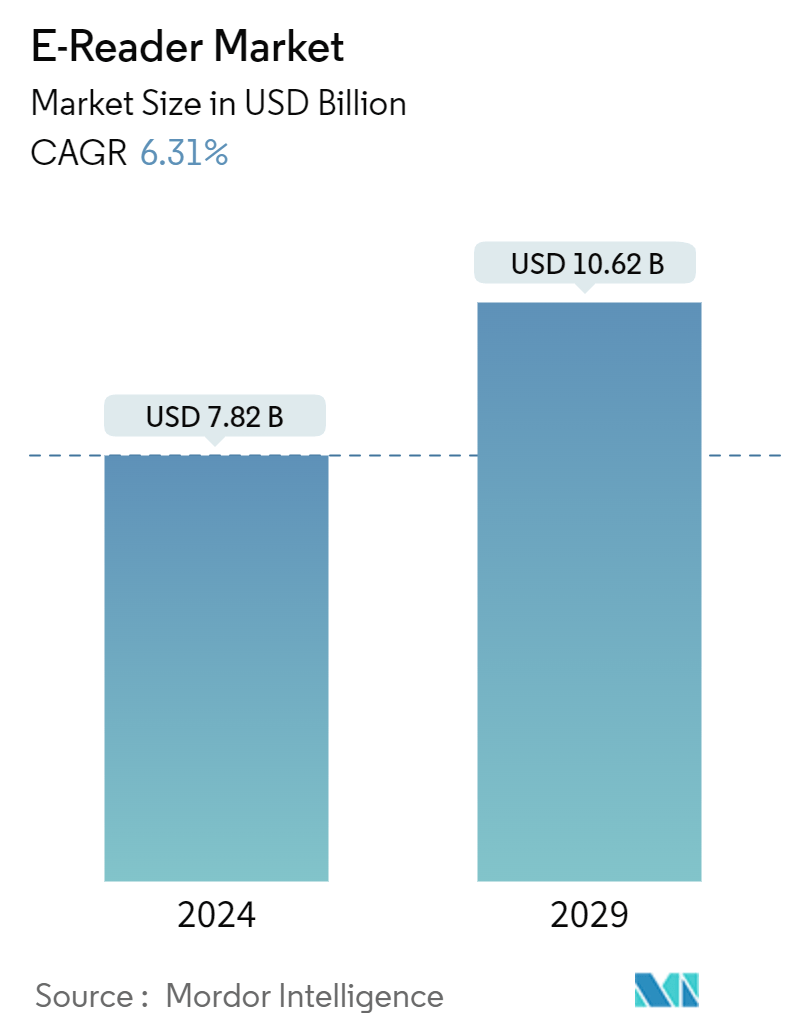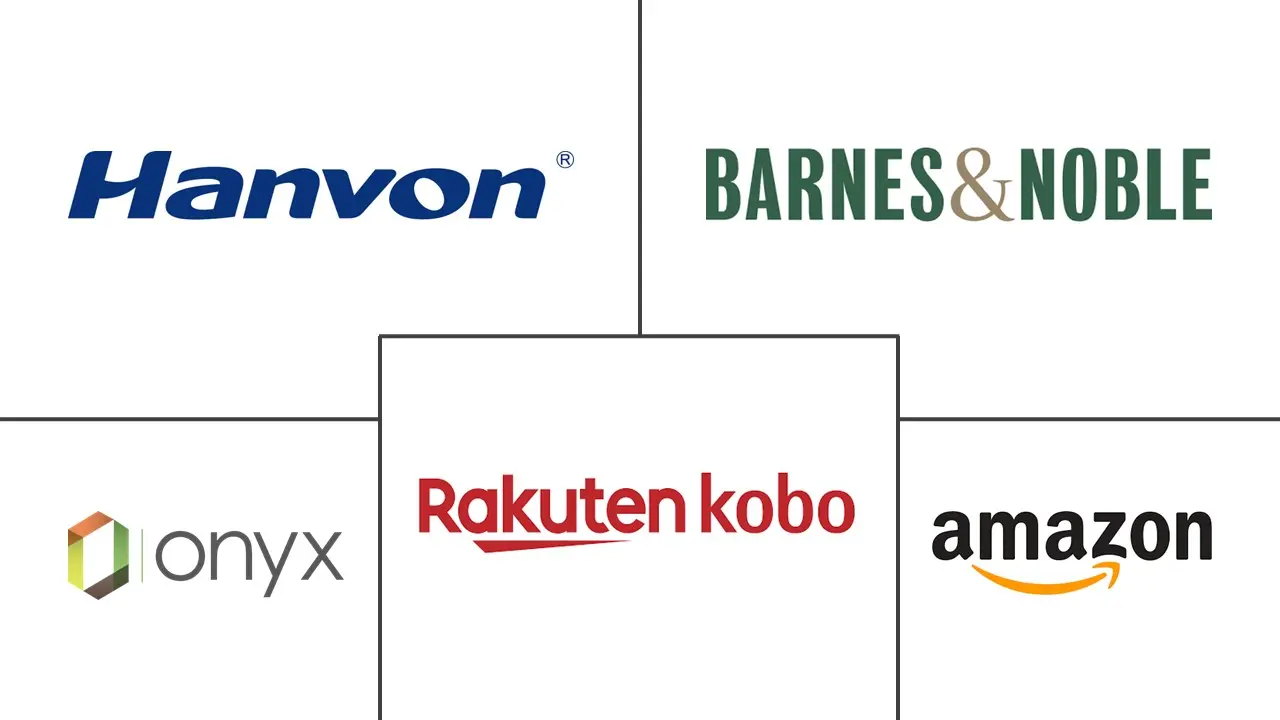Market Size of E-Reader Industry

| Study Period | 2019 - 2029 |
| Market Size (2024) | USD 7.82 Billion |
| Market Size (2029) | USD 10.62 Billion |
| CAGR (2024 - 2029) | 6.31 % |
| Fastest Growing Market | Asia Pacific |
| Largest Market | North America |
| Market Concentration | Medium |
Major Players
*Disclaimer: Major Players sorted in no particular order |
E-Reader Market Analysis
The E-Reader Market size is estimated at USD 7.82 billion in 2024, and is expected to reach USD 10.62 billion by 2029, growing at a CAGR of 6.31% during the forecast period (2024-2029).
The market's growth depends on various factors, including the growing use of E-books, E-readers' more extended battery life, and E-readers' glare/light pollution-free nature. An E-book reader or E-book device is predominantly used to read electronic copies of the book. The device can display text on the screen and optimize font size, brightness, and text level according to the reader's preferences.
- E-readers are becoming more advanced in terms of their screen technology. Today's high-resolution displays deliver improved contrast, better color accuracy, and reduced glare. This makes e-readers more similar to print books, providing users with a more comfortable reading experience. Some e-readers also feature adjustable color temperature, allowing readers to customize the display to their preferences.
- Many e-reading platforms now offer features enabling readers to connect with others who share their interests, such as online book clubs and discussion forums. Some platforms also allow readers to share notes and annotations with others, creating a more interactive reading experience. This trend will likely continue, with social reading becoming increasingly important in the e-reading landscape.
- EU Economic and Financial Affairs Council members, including Norway, have announced a cut VAT applicable on electronic publications. Recently, Germany committed to enacting laws to cut the VAT rate for e-books, online journals, and newspapers from 19% to 7%. The move comes after the EU Council agreed to allow countries to align their reduced/nil-rated physical books with their electronic counterparts. The cut has already been applied in several EU countries. Electronic Publication (EPUB) is the most widely adopted e-book file format developed by the International Digital Publishing Forum (part of the World Wide Web Consortium). Another major e-book format is the PDF, developed by Adobe. PDF format is widely used around the web because of its ease of use.
- E-reader devices have evolved into individual points of sale, allowing users to browse an unlimited selection of books and content, ranging from new releases to backlist titles to long-out-of-print titles. Digital is expanding the reading and learning experience, offering publishers new ground for talent scouting and providing authors and illustrators with new avenues for expression.
- For instance, Hachette Livre has been at the forefront of the book industry's response to technical developments and innovations. It has adapted to new kinds of reading and developing consumer behavior. On the other hand, Hachette Livre is keen to guarantee that each book's genuine value is recognized as the custodian of its authors' financial interests.
- On the contrary, the increase in the usage of audiobooks may hamper the studied market. An audiobook records a reading text orally, either word for word or shortened. It is a helpful alternative to regular books and a vital source of information for the visually impaired. Most digital devices can play audio formats like MP3 files, and companies such as Google Books and Amazon provide access to extensive libraries of books.
- Further, The Audiobook Creation Exchange (ACX) allows making and distributing digital audiobooks simple. ACX's marketplace of professional audiobook creates a digital audiobook edition of the book and earn up to 40% royalties. ACX connects with hundreds of audiobook producers, actors, and studios who may be hired for a fee or a royalty-sharing partnership at no cost.
E-Reader Industry Segmentation
E-readers, often called E-books, are electronic devices that read e-books and periodicals. An E-Reader is a digital book containing text, graphs, images, and tabular content. It is extensively used to read e-journals, e-letters, e-magazines, and other electronic publications. E-readers are designed to simulate the experience of reading on printed paper.
The global e-reader market is segmented by screen size (below 6 inch, 6-8 inch, and more than 8 inch), by geography (North America (United States and Canada), Europe (United Kingdom, Germany, France, and Other Countries), Asia Pacific (China, Japan, India, South Korea, and Other Countries), Latin America, Middle East, and Africa).
The market sizes and forecasts are provided in terms of value USD for all the above segments.
| By Screen Size | |
| Below 6 Inch | |
| 6-8 Inch | |
| More than 8 Inch |
| By Geography*** | |||||||
| |||||||
| |||||||
| |||||||
| Middle East and Africa | |||||||
| Latin America |
E-Reader Market Size Summary
The e-reader market is poised for significant growth, driven by the increasing adoption of e-books and advancements in e-reader technology. These devices, designed to provide a digital reading experience, offer features such as extended battery life, glare-free screens, and customizable display settings, making them a preferred choice for avid readers. The market is also benefiting from the integration of social reading platforms, which allow users to engage with others through online book clubs and discussion forums. This trend towards interactive and social reading experiences is expected to continue, further enhancing the appeal of e-readers. Additionally, regulatory changes in regions like the EU, which have reduced VAT rates on electronic publications, are expected to boost the market by making e-books more affordable and accessible.
The market landscape is characterized by the presence of key players such as Amazon, Barnes & Noble, and Rakuten Kobo, who are actively investing in product development and strategic partnerships to capture a larger market share. The proliferation of mobile devices and the increasing penetration of the internet are also contributing to the market's expansion, as they facilitate easier access to digital content. However, the rise of audiobooks presents a potential challenge, offering an alternative to traditional reading. Despite this, the e-learning sector's growth, driven by the demand for distance learning and smart technology integration, presents new opportunities for the e-reader market. As companies continue to innovate and expand their offerings, the e-reader market is expected to experience robust growth in the coming years.
E-Reader Market Size - Table of Contents
-
1. MARKET INSIGHTS
-
1.1 Market Overview
-
1.2 Industry Attractiveness - Porter's Five Forces Analysis
-
1.2.1 Bargaining Power of Buyers
-
1.2.2 Bargaining Power of Suppliers
-
1.2.3 Threat of New Entrants
-
1.2.4 Threat of Substitutes
-
1.2.5 Intensity of Competitive Rivalry
-
-
1.3 Industry Value Chain Analysis
-
1.4 Assessment of the Impact of COVID-19 on the Market
-
-
2. MARKET SEGMENTATION
-
2.1 By Screen Size
-
2.1.1 Below 6 Inch
-
2.1.2 6-8 Inch
-
2.1.3 More than 8 Inch
-
-
2.2 By Geography***
-
2.2.1 North America
-
2.2.1.1 United States
-
2.2.1.2 Canada
-
-
2.2.2 Europe
-
2.2.2.1 United Kingdom
-
2.2.2.2 Germany
-
2.2.2.3 France
-
-
2.2.3 Asia
-
2.2.3.1 China
-
2.2.3.2 Japan
-
2.2.3.3 India
-
2.2.3.4 South Korea
-
2.2.3.5 Australia and New Zealand
-
-
2.2.4 Middle East and Africa
-
2.2.5 Latin America
-
-
E-Reader Market Size FAQs
How big is the E-Reader Market?
The E-Reader Market size is expected to reach USD 7.82 billion in 2024 and grow at a CAGR of 6.31% to reach USD 10.62 billion by 2029.
What is the current E-Reader Market size?
In 2024, the E-Reader Market size is expected to reach USD 7.82 billion.

